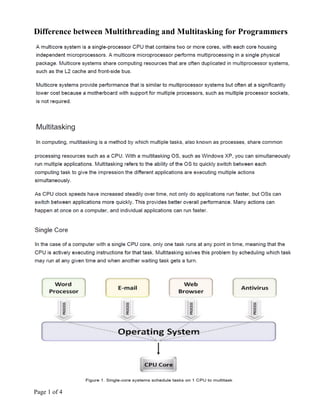
Simple difference multi_threading_tasking
- 1. Difference between Multithreading and Multitasking for Programmers Page 1 of 4
- 2. Page 2 of 4
- 3. Why Dataflow Programming Languages are Ideal for Programming Parallel Hardware (according to ni company) Dataflow programming models contrast to the control flow model (implemented in languages such as C). Because of the top-down sequential programming approach, applications written in C have inherent limitations when mapping to parallel hardware. In contrast, with a dataflow model, nodes on a block diagram are connected to one another to express the logical execution flow, and they can be used to easily express parallelism. When a block diagram node receives all required inputs, it produces output data and passes that data to the next node in the dataflow path. The movement of data through the nodes determines the execution order of the functions on the block diagram. SOURCE: www.ni.com/multicore This document is part of the Multicore Programming Fundamentals Whitepaper Series Page 3 of 4
- 4. “process” is an instance of a computer program that is being executed. While a program itself is just a passive collection of instructions, a process is something which actually executes those instructions. Several processes can be associated with the same program - each would execute independently. Modern computer systems allow multiple processes to be loaded into memory at the same time and, through time-sharing (or multitasking), give an appearance that they are being executed at the same time even if there is just one processor. In modern operating systems, each process can have several threads of execution (or threads for short). Multiple threads share the same program code, operating system resources (such as memory and file access) and operating system permissions (for file access as the process they belong to). A process that has only one thread is referred to as a single-threaded process, while a process with multiple threads is referred to as a multi-threaded process. Multi-threaded processes have the advantage that they can perform several tasks concurrently without the extra overhead needed to create a new process and handle synchronized communication between these processes. Threads can be thought of as lightweight processes, offering many of the advantages of processes without the communication requirements that separate processes require. Threads provide a means to divide the main flow of control into multiple, concurrently executing flows of control. Application / Program Task Proces Threa Series of Related Instructions Page 4 of 4
